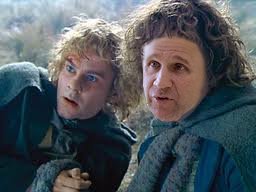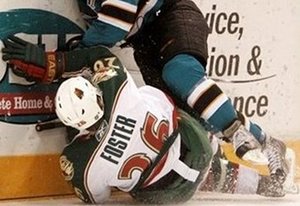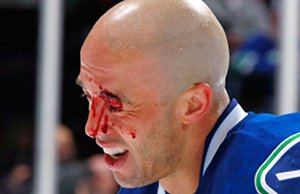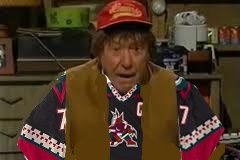 The NHL entered a new era this season, when someone at NHL head office realized that Colin Campbell’s ineptitude is exceeded only by his hobbit-ude. Gone is the infamous Wheel of Justice which was so ineffable that Miss Cleo did a special infomercial promising accurate predictions on suspension lengths. Brendan Shanahan – ShanaBan, to his new head-office friends – has been promoted to Vice President of Player Safety and Something Else I Can’t Remember So It Probably Isn’t Important. Accompanying the personnel change was a stricter definition of what constitutes an illegal hit to the head, and a newfound transparency in the assessment of individual incidents. While the concept of a video explanation of every suspension – and some non-suspensions – is a cosmic leap forward from the NHL’s policy under the previous disciplinarian, the NHL made few other changes to its game. Here are seven things they could have done to make the NHL a more attractive brand.
The NHL entered a new era this season, when someone at NHL head office realized that Colin Campbell’s ineptitude is exceeded only by his hobbit-ude. Gone is the infamous Wheel of Justice which was so ineffable that Miss Cleo did a special infomercial promising accurate predictions on suspension lengths. Brendan Shanahan – ShanaBan, to his new head-office friends – has been promoted to Vice President of Player Safety and Something Else I Can’t Remember So It Probably Isn’t Important. Accompanying the personnel change was a stricter definition of what constitutes an illegal hit to the head, and a newfound transparency in the assessment of individual incidents. While the concept of a video explanation of every suspension – and some non-suspensions – is a cosmic leap forward from the NHL’s policy under the previous disciplinarian, the NHL made few other changes to its game. Here are seven things they could have done to make the NHL a more attractive brand.
1. One of the most pressing issues from the off-season was the role of the scrapper in professional hockey. After the tragic passing of Derek Boogaard, Rick Rypien and Wade Belak – all noted more for their fisticuffs than their skill in other aspects of the game – calls came from many to eliminate fighting in the NHL. I have always been a fan of hockey fights, but it’s tough to look at the suicides of three men who made their living as little more than bare-knuckle brawlers on ice skates and endorse a destructive activity that’s tangential at best to the game of hockey.
Views on fighting are far from unanimous, however. Within the NHL ranks opinions run the gamut from those who think that fighting is a necessary part of the game, and cuts down on behind the play stick infractions, to those who think fighting can safely go the way of the dinosaurs and FOX’s fall lineup. Whether you agree with it or not, the evidence is incontrovertible: repeated blows to the head cause brain injury, and the NHL should act to reduce or eliminate fighting. My solution is simple, and would require only a small change to the current rule. The instigator rule currently requires that a player be deemed both the “instigator and the agressor” of a fight. This means that a player basically has to mug another in order to get the extra penalty. The NHL should delete the requirement that a player also be the agressor; while not a complete solution, this would at least deter players from goading others into a scrap, particularly after hard but legal hits.
 2. Continuing with the player safety theme, the NHL has been experimenting with alternatives to the icing rule. The league has recognized that change is necessary since at least 2008-09, when a gruesome injury to Kurtis Foster led to a new rule that required a penalty be called for any contact during a race for an iced puck. It is a problem unique to professional hockey in North America. Elsewhere in the world, no-touch icing is the standard, and icing-related injuries are unheard of. According to reports from the most recent meeting of NHL general managers, however, there is no appetite for adopting no-touch icing; for one thing, there is a fear that, if implemented, players will be reluctant to try stretch passes, or the patented Sedin slapshot into the corner. It seems, though, that a compromise has been gaining traction: “hybrid” icing.
2. Continuing with the player safety theme, the NHL has been experimenting with alternatives to the icing rule. The league has recognized that change is necessary since at least 2008-09, when a gruesome injury to Kurtis Foster led to a new rule that required a penalty be called for any contact during a race for an iced puck. It is a problem unique to professional hockey in North America. Elsewhere in the world, no-touch icing is the standard, and icing-related injuries are unheard of. According to reports from the most recent meeting of NHL general managers, however, there is no appetite for adopting no-touch icing; for one thing, there is a fear that, if implemented, players will be reluctant to try stretch passes, or the patented Sedin slapshot into the corner. It seems, though, that a compromise has been gaining traction: “hybrid” icing.
Here’s how it works. If there is no race for the puck, the linesman blows his whistle as soon as the puck crosses the goal line, just like in international hockey. If, however, two players are competing for the puck, the linesman makes a decision when the players reach the faceoff dots. If the attacking player is in front, play will continue until one or the other touches the puck. If, however, the two players are tied, or the defenceman is in front, icing will be called when the puck crosses the goal line, giving the players plenty of time to let up and avoid any potential collisions. Implementation of this rule seems like a no-brainer, and will hopefully be approved for next season.
 3. At the risk of Don Cherry calling me a puke, I’m going to continue harping on player safety now. Manny Malhotra’s career was nearly ended by a stray puck to the eye; it’s mind-boggling to me that there are Vancouver Canucks who witnessed that and continue to play without a visor. There is no excuse – none – for the NHL not immediately requiring the use of visors for all players. At a bare minimum, it should be grandfathered in as helmets were in the 80s.
3. At the risk of Don Cherry calling me a puke, I’m going to continue harping on player safety now. Manny Malhotra’s career was nearly ended by a stray puck to the eye; it’s mind-boggling to me that there are Vancouver Canucks who witnessed that and continue to play without a visor. There is no excuse – none – for the NHL not immediately requiring the use of visors for all players. At a bare minimum, it should be grandfathered in as helmets were in the 80s.
4. On October 6, 2011, the Pittsburgh Penguins played in Vancouver. Sidney Crosby, the NHL’s poster boy, did not. As a result, under the current scheduling system, Crosby will go at least 45 months – nearly FOUR YEARS – between games in Vancouver. The NHL schedule is currently only slightly less ridiculously unbalanced than it was immediately after the lock-out. The current formula is as follows: 6 games against each divisional opponent (24 games), 4 games against every other team in your conference (40 games), 1 game against every team in the other conference (15 games) and 3 extra games played against teams from the other conference, for a total of 82 games. With this system, fans in any given city miss out on seeing six teams every year. Sure, sometimes you’ll get lucky and not have to watch the Panthers, but it’s just as likely you could miss the Bruins or Capitals, both of whom are good draws.
The league is also devaluing the Presidents Trophy by emphasizing divisional play. In 2010, the Washington Capitals had the highest point total in the league. They were also the only team from their division to make the playoffs. In 2006, the Red Wings racked up 124 points by beating up on divisional “opponents” Columbus, Chicago and St Louis who finished 13th-15th, respectively, in the conference. When a good team plays four to six extra games against weak teams in their division, it skews the standings and makes it less likely that a team in a competitive division will win the regular season. A more balanced schedule would give a much clearer picture of who the best teams in the regular season actually are. The league’s rationale for the unbalanced schedule has always been that it promotes divisional rivalries. I, for one, would rather see Ovechkin twice a year than the Minnesota Wild six times.
5. While the league is tinkering with the schedule, they can tinker with the standings, too, and do away with their ridiculous point system. It’s not that the current system seriously impacts the standings – it’s rare that a team shifts more than one place either way – rather, it addresses a problem that no longer exists. The loser point was originally a means of combatting boring overtimes where teams would play tight defensive hockey to ensure they got at least a single point. With the introduction of the shootout, there is no longer any such need. The only reason the loser point remains is so Gary Bettman can talk about parity in the league.
In 2010-11, there were 291 overtimes games in the NHL – that’s nearly 24% of all games, if you’re scoring at home – and therefore 291 loser points awarded, with no way for teams to make up that ground. This leads to wacky situations like last year’s Western Conference standings, where the 4th place Anaheim Ducks finished only five points ahead of the 10th place Calgary Flames, despite wining ELEVEN more games in regulation and overtime than the Flames. Voila! Parity! Or so it seems until you watch the teams play and realize that the Flames are much more than five points worse than the Ducks. The NHL should do away with this confusing mess and make every game worth three points: all three points for a regulation or overtime win, 2 for a shootout win, 1 for a shootout loss. Under that system, the Ducks would have had 139 points last year to the Flames’ 121: a much more representative gap. It’s a system that would reward good teams who take care of business early, while softening the blow of losing in the somewhat random shootout.
6. You never want to see a bad call affect the outcome of a game. Unfortunately, in a game as fast as NHL hockey, even the best officials – and make no mistake, the NHL has damn good officials – are bound to miss things. For a prime example, think back to game five of last year’s Western Conference Final when, late in the third period, the puck appeared to deflect off of a Canuck on a San Jose clearance. The play was incorrectly ruled icing, and the Canucks tied the game on the ensuing faceoff. In an age where every game is covered by innumerable cameras from various angles, the league should be embracing that technology. One proposal is a coach’s challenge system similar to that employed by the CFL and NFL, but I say take it a step further. In soccer, officials these days wear headsets to communicate with their partners. There’s no reason that NHL officials can’t adopt similar technology to stay in constant communication with both on- and off-ice officials. Imagine, for instance, if a delay of game penalty for clearing the puck over the glass could be waved off before the player had a chance to sit down in the penalty box, because the off-ice official looked at the replay and saw clearly that the puck was deflected. It would take some time for the league to work out the exact roles and responsibilities of the off-ice officials, and which calls are allowed to be reviewed or overruled, but there is no reason the league shouldn’t begin experimenting with expanded use of technology in refereeing.
 7. I’m one of very few people I know who find the sunbelt expansion experiment to be laudable. We have a great game up here, and I think putting expansion teams in non-traditional markets was worth a try. (Before you start beating me up, Manitobans, I’m just talking about expansion. I was dead set against relocation.) Now, however, the time has come to end a couple of these experiments.
7. I’m one of very few people I know who find the sunbelt expansion experiment to be laudable. We have a great game up here, and I think putting expansion teams in non-traditional markets was worth a try. (Before you start beating me up, Manitobans, I’m just talking about expansion. I was dead set against relocation.) Now, however, the time has come to end a couple of these experiments.
First on the list: the Phoenix Coyotes. I’d call the Phoenix situation a farce, but that doesn’t quite do it justice. It’s more of a Royal Canadian Air Farce: nobody’s watching, because it’s not funny and a little bit embarrassing. The optics of the league having to finance a franchise for not one but multiple seasons are awful. At this point, the Coyotes brand is so thoroughly damaged that, even if a viable Phoenix owner is found, we’re talking a decade-long process just to get the club back to something approaching respectability. Best to cut losses and find the team a fresh start in another city.
Close behind the ‘Yotes is Florida. The Panthers have managed to stay out of the bottom five in attendance in recent years, but only through unbelievable discounts. Last year, the Miami-based team ran a special season ticket offer of $6 per game for upper bowl seats. That’s $246 for the SEASON! By contrast, a single ticket in club seating for a Canucks/Ducks game in April costs $255. When you have to sell tickets that cost less than your crappy American stadium beer, it’s time to find a town where the residents have seen ice outside of a freezer.
These teams have now had 15 years or more to get their act together, and it hasn’t happened. Quebec City wants its team back. Seattle’s been on the NHL’s radar since the late 60’s. Jim Balsillie would make a fabulous owner in southern Ontario. It’s time for the NHL to stop throwing good money after bad in Sunrise and Glendale.
{jcomments on}

